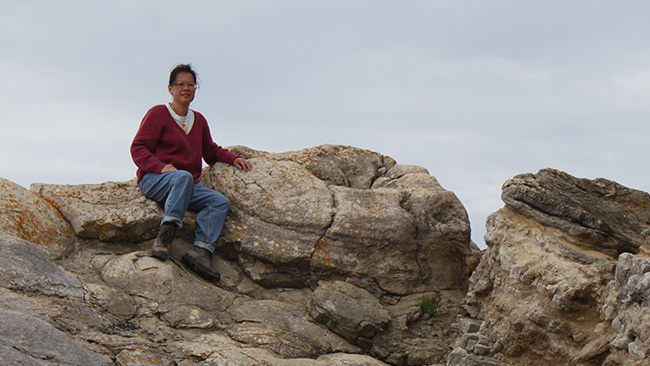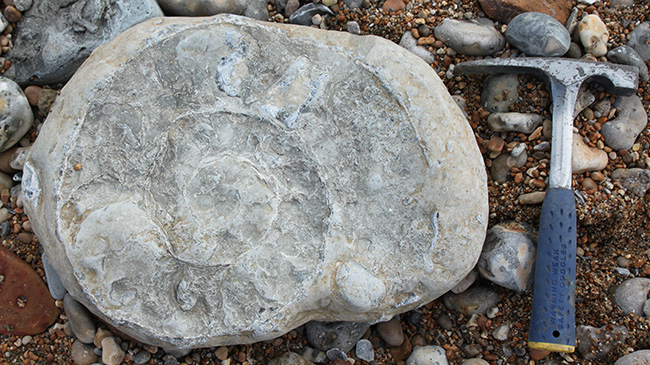Internationally renowned paleobotanist, Dr. Carole Gee will visit IU Southeast to deliver two presentations on plant evolution, one to students and one to the public. Currently a member of the teaching and research faculty in both the Geosciences (Paleontology) and the Department of Organismic and Evolutionary Biology and Paleobiology at the University of Bonn in Germany, Dr. Gee has published numerous groundbreaking original research articles and co-edited four books on aspects of fossil plants. She works in collaboration with IU Southeast biology professor David Winship Taylor on ancient water lilies, and edited the book, Plants in Mesozoic Times (2010), published by Indiana University Press. She spoke about her life and work with IU Southeast academic information officer, Steven Krolak.
How did your childhood experiences lead to a career in paleobotany?
As a city girl in the sprawling metropolis of Los Angeles, I reveled in school field trips. Not only because it meant a day off from class, but also because I adored being outdoors in the sunshine under the deep blue California sky. The best field trips were to the tide pools at the Pacific coast and the piney woods in the San Bernardino Mountains; here I learned to love the “Great Outdoors.” On the other hand, I was also fascinated by science museums such as the Cabrillo Marine Aquarium, Natural History Museum of L.A. County and the California Museum of Science and Industry (now called the California Science Center). Much later, while searching fro my calling in college, I decided to become a plant paleontologist, for it allowed me to continue to enjoy a variety of exciting experiences indoors and out. For me as a paleobotanist now, the best times of the year are spent doing fieldwork in the Utah desert and German lignite mines, as well as leading student field trips to fun places such as England, Switzerland or Texas to collect fossils, but I also love working in the lab with microscopes of all sorts, puttering around the chemistry lab, as well as teaching, doing scholarly research and writing up results at the university.
What can paleobotany tell us about dinosaurs?
As the primary producers in nearly all ecosystems on Earth, plants form the basis of the food chain. Plants also build habitats such as forests and woodlands in which animals eat, reproduce and live their entire lives. During the Jurassic, there were deep green tropical forests that look a lot like those we have today, but the forests some 160 million years ago were made up of fan-leaved ginkgoes, towering cycads and curious-looking monkey-puzzle trees. These tall plants provided fodder for the plant-eating dinosaurs, especially for the larger, fully grown, long-neck sauropod dinosaurs. Younger individuals and smaller species munched on ground-dwelling ferns and low-growing horsetails.

Dr. Carole Gee beside a c. 155 million year old tree stump at the Purbeck fossil forest at Lulworth Cove on the coast of Southern England, one of the few places on Earth where trees were fossilized in an upright position, enabling paleobotanists to study them in an ecosystem context.
How does taphonomy, the study of what happens to organisms after death and during fossilization, contribute to our understanding of past biodiversity?
In any fossil assemblage, we find only a small fraction of the biodiversity of the past. The study of the formation, or taphonomy, of a fossil assemblage tells us which physical processes — mechanical, chemical or geological — have sieved out the biological information in the plants and animals and in the living community as a whole during the transformation and preservation of the living organisms into fossils. Understanding these sieves or biases in fossilization is important in being able to reconstruct an accurate picture of life in the past. Sometimes it works the other way around, and there is an over-representation of a certain organism in the fossil record. For example, if you know that pine trees produce a lot of pollen that can be distributed great distances by wind, then finding pine pollen at a fossil site does not necessarily mean that a pine forest grew right there, but may have flourished some distance away.
Your work with x-ray microtomography has led to a new understanding of plant species diversity in Jurassic times. Why is this technology so useful in research?
The new electronic and digital technologies that have radically changed our everyday lives have also transformed paleontology. In the past, paleobotanists were forced to saw up and grind their rock-hard fossils into thins slices for microscopic study, which was a tedious, and time- and labor-consuming process. Nowadays, however, with the advent of high resolution x-ray microtomography (or “micro-CT”), plant fossils can be imaged non-destructively using powerful x-rays, which leaves the beautiful and valuable fossils intact, but extracts the necessary scientific information from deep within the object. 3D imaging software makes it possible to reconstruct the internal structure of the fossil plants with greater insight and understanding of the similarities and differences between species. These new methodologies also often prove to be more efficient, precise and convenient.

A 163-million year old giant ammonite fossil, recently discovered by Dr. Gee near Weymouth in southern England.
In your view, what are the most interesting unexplored frontiers in paleobotany?
The most interesting frontiers in paleobotany are those that creatively explore the realm of possbilities using new technologies and approaches. This includes x-ray techniques using CT and the synchrotron for non-destructive imaging of internal structures. In addition, the application of phylogenetic analysis — elucidating evolutionary relationships between species using objective criteria and the mighty computing power of modern electronic devices — also gives us insight into the evolution of plants. This sort of phylogenetic research is what David Taylor and I are currently doing on fossil water lilies, to find out when they first show up, where they originated, what they looked like and how they evolved into the delightful floating flowers and whimsical lily pads that grace our frog ponds today.
Dr. Carole Gee will speak on “What, when and where: The evolution of land plants from an herbivore’s perspective,” on Monday, Oct. 5, 2015 at 12:20-1:10 p.m. in LF 244. She will also hold a public presentation on Tuesday, Oct. 6, 2015 at 4:30 p.m. in the IU Southeast Library, third floor. For more information please contact Dr. David Taylor at 812-941-2337 or dwtaylo2@ius.edu.


